Appearance and Design
The design and styling of the w2207 is clearly intended to make it stand out from the crowd. Whether or not that's a good thing depends on your own personal preference. For better or for worse, the w2207 comes with a glossy mirror-like finish that can serve as a magnet for fingerprints and dust. If you have grubby fingers - or others in your house that do - you may find yourself spending an inordinate amount of time wiping down the exterior of this display.
The front of the LCD is a combination of glossy black for the border around the panel, while the stand is silver with a rough texture. At the bottom right of the LCD, we get the usual buttons for accessing the on-screen display (OSD). The left button brings up the OSD, at which point all four buttons can be used to navigate the menus. Prior to entering the menu, the right button can be used to execute the auto adjustment function (for use with analog connections), the second button brings up volume control, and the third button cycles between five display modes (movie, photos, games, text, and user defined). The power button, incidentally, is located on the top of the chassis and glows a faint orange/blue depending on whether the display is powered on or in standby mode.
As mentioned already, you can pivot the display into portrait mode, which some people find useful for reading long web pages or documents. You will need to raise the LCD before pivoting as well as tilting the panel back a bit, and afterwards there were only be an inch or two of vertical travel available.
The back of the display is primarily composed of black plastic, again with a rough texture. Ventilation slots can be seen around the border, and you can also get a better view of the base stand. The main panel sits on a cantilevered arm that ends up making the display quite a bit deeper than it would otherwise need to be. The main panel can also be laid flat against the base stand, which is how the unit is shipped, though it doesn't seem practical to try using the LCD in that position.
The expected input ports are all present on the rear of the display, facing downwards. DVI and VGA inputs are available, a USB input is located at the far right, and in the center is an audio jack. Nearly all of the necessary cables are included, although it wasn't clear whether a DVI cable comes with the LCD or not. Our unit arrived without a DVI cable, and considering that's our preferred connection for LCDs we would certainly like to see a DVI cable rather than a VGA cable included - and ideally both of them. The included speakers, incidentally, are all but useless. Even in a quiet room, it is difficult to hear audio through them, and the quality of audio they can provide is lacking at best.
Looking at the profile of the LCD, we see the range of motion that the base stand offers. Two USB ports are located on the left side, while the right side is empty. You can also see how the base stand extends several inches behind the back of the display.
One of the features that HP advertises with the w2207 is their Easy Clip accessory kit that can be used to hold papers, pens, or other useful bits of information. We did not get the accessory kit with our review unit, but they did send us a webcam that attaches to the top of the display. The webcam we received is not the same model that we see shown on the online ordering pages, so we're not sure how much it actually costs. We can say that it functioned pretty much as you would expect from a webcam, and if you're the type of person that likes to use such a device the ability to easily connect it to the top of your display might make the addition worthwhile. If you don't plan on using the webcam, of course, save your pennies!
The design and styling of the w2207 is clearly intended to make it stand out from the crowd. Whether or not that's a good thing depends on your own personal preference. For better or for worse, the w2207 comes with a glossy mirror-like finish that can serve as a magnet for fingerprints and dust. If you have grubby fingers - or others in your house that do - you may find yourself spending an inordinate amount of time wiping down the exterior of this display.
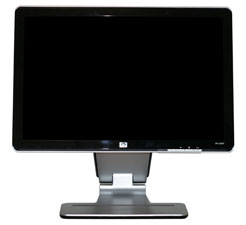 |
 |
The front of the LCD is a combination of glossy black for the border around the panel, while the stand is silver with a rough texture. At the bottom right of the LCD, we get the usual buttons for accessing the on-screen display (OSD). The left button brings up the OSD, at which point all four buttons can be used to navigate the menus. Prior to entering the menu, the right button can be used to execute the auto adjustment function (for use with analog connections), the second button brings up volume control, and the third button cycles between five display modes (movie, photos, games, text, and user defined). The power button, incidentally, is located on the top of the chassis and glows a faint orange/blue depending on whether the display is powered on or in standby mode.
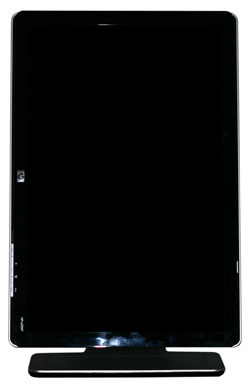 |
As mentioned already, you can pivot the display into portrait mode, which some people find useful for reading long web pages or documents. You will need to raise the LCD before pivoting as well as tilting the panel back a bit, and afterwards there were only be an inch or two of vertical travel available.
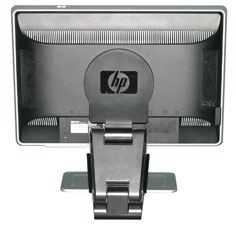 |
 |
The back of the display is primarily composed of black plastic, again with a rough texture. Ventilation slots can be seen around the border, and you can also get a better view of the base stand. The main panel sits on a cantilevered arm that ends up making the display quite a bit deeper than it would otherwise need to be. The main panel can also be laid flat against the base stand, which is how the unit is shipped, though it doesn't seem practical to try using the LCD in that position.
 |
The expected input ports are all present on the rear of the display, facing downwards. DVI and VGA inputs are available, a USB input is located at the far right, and in the center is an audio jack. Nearly all of the necessary cables are included, although it wasn't clear whether a DVI cable comes with the LCD or not. Our unit arrived without a DVI cable, and considering that's our preferred connection for LCDs we would certainly like to see a DVI cable rather than a VGA cable included - and ideally both of them. The included speakers, incidentally, are all but useless. Even in a quiet room, it is difficult to hear audio through them, and the quality of audio they can provide is lacking at best.
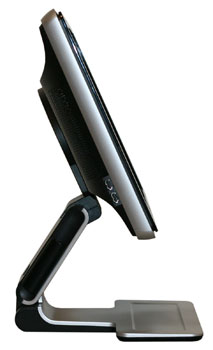 |
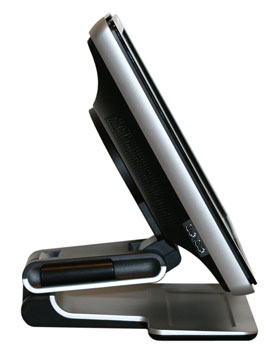 |
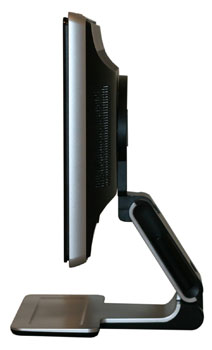 |
 |
Looking at the profile of the LCD, we see the range of motion that the base stand offers. Two USB ports are located on the left side, while the right side is empty. You can also see how the base stand extends several inches behind the back of the display.
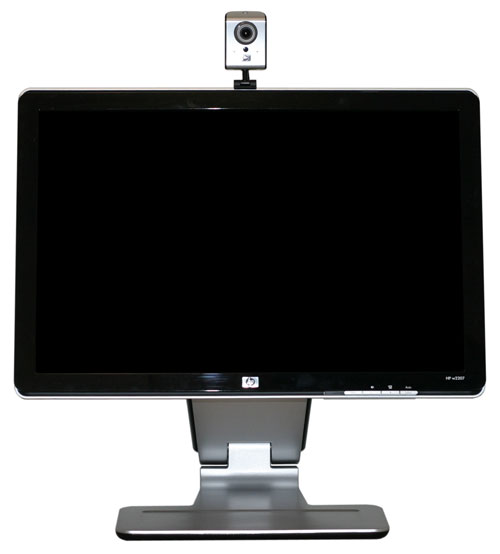 |
One of the features that HP advertises with the w2207 is their Easy Clip accessory kit that can be used to hold papers, pens, or other useful bits of information. We did not get the accessory kit with our review unit, but they did send us a webcam that attaches to the top of the display. The webcam we received is not the same model that we see shown on the online ordering pages, so we're not sure how much it actually costs. We can say that it functioned pretty much as you would expect from a webcam, and if you're the type of person that likes to use such a device the ability to easily connect it to the top of your display might make the addition worthwhile. If you don't plan on using the webcam, of course, save your pennies!










43 Comments
View All Comments
jc44 - Thursday, August 2, 2007 - link
Initially that would have been the approx asking price (medical applicatinos I think). They got cheaper as time went on though they were never exactly cheap. The Viewsonic (VP2290B) and Iiyama badged versions got under ~$7000 I think (which was approx twice the price on an Apple 30" at the time). Currently a DG5 (the last iteration) goes for ~$3500 on ebay and a VP2290B is ~$1000.The T221 was the first monitor that made me think "The best LCDs are btter than the best CRTs - now they only have to get cheap enough".
I was really hoping that they would take off and the price would come down to something like the current ebay prices. (And yes I did buy off ebay in the end)
Great Googly Moogly - Friday, August 3, 2007 - link
Aye, they're pretty damn cool. I've yet to see one in the flesh though. You still have to have 2 dual-link cards with it though? Doesn't it use 4 single-link connectors?And isn't the 48 Hz data rate (all 4 links) OK enough? (Yeah yeah, TFTs don't have refresh rates, I know, but there are other ramifications of a slow data rate.)
yacoub - Wednesday, August 1, 2007 - link
Not sure why 22" is starting to become prominent over 20". Must be cheaper to produce because tolerances and processes don't have to be as tight, since they're the same resolution just a larger (and thus more visible) pixel pitch on the 22" (0.282mm). Would rather stick with a 20", or if I want bigger then I'd get a 23-24" with 1920x resolution.Jedi2155 - Wednesday, August 1, 2007 - link
When comparing TN 20" versus a 22" panel with around $50 difference, i'd definitely go for the 22" mainly due to the larger screen space which makes games and movies more life-like.Sure the resolution hasn't changed, but why do people buy big screens with lower resolutions anyways? Just to get the bigger picture of course.
Oh, I also think there is a typo on Page 5 at the last paragraph.
You mentioned
But shouldn't it be
JarredWalton - Wednesday, August 1, 2007 - link
I corrected the Acer/Acer sentence -- HP seemed to be a bit better in the vertical plane. Things for the comment.nilepez - Wednesday, August 1, 2007 - link
I think the difference is that if you buy an 70" HDTV, you're not sitting as close as you are if you have a 42". Besides, a smaller TV with accurate colors trumps a big POS set with crap colors (and I've seen some awful HD monitors).
As a result, if the colors are better on the 20", I'd go with a 20".
JarredWalton - Wednesday, August 1, 2007 - link
I think a lot of the better 20" LCDs were IPS or PVA, which might account for the prices as well. Dell I'm pretty sure was IPS on the 2005FP (and FPW?). I think the cheaper 20" LCDs are now also using TN panels. Could be that they can only get the same amount of 22" or 20" panels out of a modern glass substrate, though... I haven't looked into it closely.Spoelie - Wednesday, August 1, 2007 - link
P-MVA and A-MVA are disregarded in the article, even though they are among the best 'overal' monitor technologies, for 20" at least. Second fastest response time, 8 bit color, best movie picture quality, homogeneous viewing angles. It's superior to PVA anyway.JarredWalton - Wednesday, August 1, 2007 - link
I thought MVA and PVA were similar and only certain patents created separate names. Guess not. :) I have never actually tested an MVA panel to my knowledge, and most high-end panels use IPS these days. The next tier uses PVA, and then the lower quality stuff uses TN. The one of the days, though, I will hopefully get the chance to test an MVA panel in person.mostlyprudent - Wednesday, August 1, 2007 - link
I have been using an HP LP series LCD which uses (at least when I bought it) an S-IPS panel. I could never go back to a TN or other panel with less acurate color display.